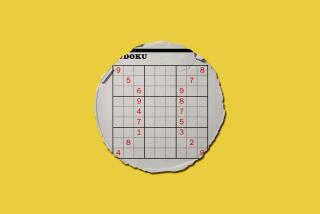Her solution to Sudoku? Music
- Share via
Like many Sudoku fans, composer Tamar Diesendruck bought her first book of the number puzzles as a way to put off working her actual day job.
“I bought one of the giant black-belt level books and became addicted,” she said. “I felt guilty, I spent all day playing it instead of composing.”
But the mathematical patterns inherent in the game soon revealed themselves to be more than a seductive waste of time and rubber erasers. It became the rule book for her newest, and possibly strangest composition. “Sudoku Variations,” which pianist Elaine Chew performs tonight in its world premiere on a program titled “The Mathematics in Music,” is a playful and rhythmically extravagant example of how musical themes can be reinvented within a strict, if especially peculiar, formal setting.
Diesendruck, a visiting associate professor of composition at USC, derived the structure of “Sudoku Variations” from the game’s goal of arranging the numbers one through nine in a 9-square by 9-square grid. No number can repeat within a given line, nor in any of the 3-square by 3-square grids inside the puzzle. The result is a precise but never-repeating grid of numbers.
After finishing a few of the simple-yet-confounding puzzles, Diesendruck felt rhythms within the game’s many structural layers. “Sudoku Variations” uses the numbers as cues for musical meter, which add up to a perfect pattern but lend a stream-of-consciousness feel to its consistently reappearing themes.
“It appealed to me to work on this crazy idea,” Diesendruck said. “Each line has the same number of beats. It feels random but it isn’t random, you teach yourself to feel it.”
The piece is, by design, manically difficult, particularly in later passages that require the pianist’s two hands to play rapid scales in different time signatures. Diesendruck composed the piece specifically for Chew, an engineer and head of the Music Computation and Cognition Laboratory at USC. Chew’s technical and exacting performance style is a natural fit for the unusual demands of “Sudoku Variations.”
“I want to know how a piece ticks, and in that sense I’m closer to a theorist,” Chew said. “Rules give you room to be creative, and set the stage for what you can do.”
Despite its meticulous structure, “Sudoku Variations” isn’t just a cerebral exercise. The piece begins with spry statements of its main themes, which turn bombastic, plaintive and eventually intertwine in a flurry of melodic runs. The piece also calls for rubber stoppers to be placed inside the piano, so certain notes create a jarring but amusing percussive effect.
“The opening is whimsical, it’s like someone dancing on their toes,” Diesendruck said. “Then it gets mock-dramatic, placid and then more driven. Some parts of it sound like folk music.”
The musicality of “Sudoku Variations” is what moves the composition beyond its quirky conceit. “There’s no reason why this should work,” Chew admitted. “It’s just a sequence of numbers put together. It’s [Diesendruck’s] artistic choices and sensibility that ties it together.” When the motifs add up and repeat themselves in new contexts, the puzzles reveal bigger melodic ideas at play.
The piece is part of a larger program that explores ideas of theme and variation. The opening work, Tcherepnin’s “Fetes (Variations on Happy Birthday),” takes versions of the familiar tune through styles as varied as jazz and Baroque while accompanied by a computer program that visually maps out the melodies on a projection screen. The closing work, “Doubles III,” by Peter Child, is a homage to favorite melodies from Chew’s childhood also composed specifically for the pianist.
The strategies behind process-driven compositions, such as John Cage’s dice-rolling chance pieces, aren’t new. Diesendruck has written other compositions with what she describes as similar “ridiculous constraints.” But rather than limit their ideas, the particular idiosyncrasy of “Sudoku’s” rules proved refreshing for Chew and Diesendruck to work within.
“It’s not a predictable dramatic arc,” Diesendruck said. “It’s a chain that adds up as you go along. It feels like windows to different worlds.”
*
‘The Mathematics in Music’
When: 7:30 tonight
Where: USC’s Alfred Newman Recital Hall, 3616 Trousdale Parkway, Los Angeles
Tickets: Free
Information: (213) 740-6786
More to Read
The biggest entertainment stories
Get our big stories about Hollywood, film, television, music, arts, culture and more right in your inbox as soon as they publish.
You may occasionally receive promotional content from the Los Angeles Times.











